July 24, 2016
Martha O'Kennon
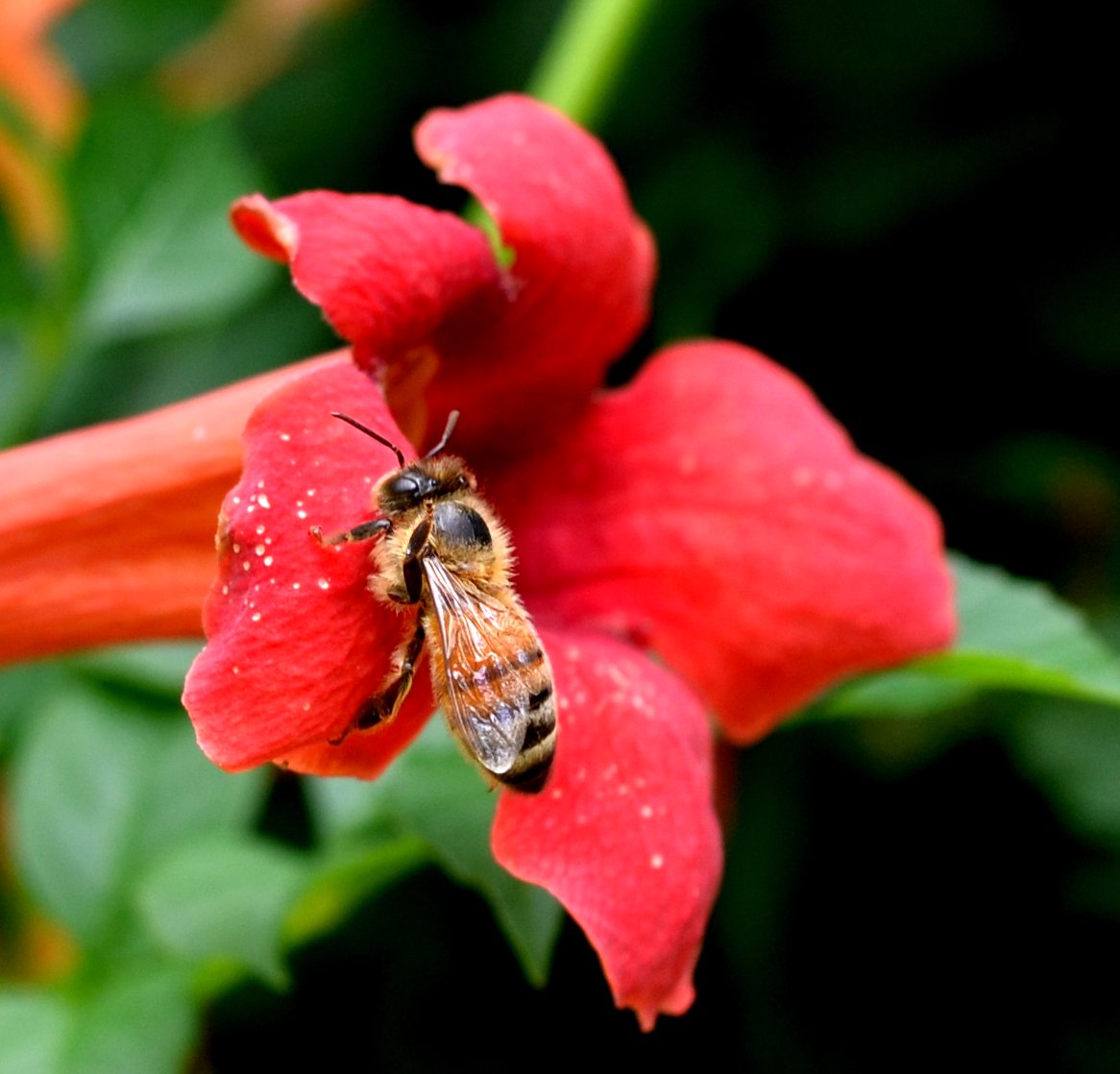
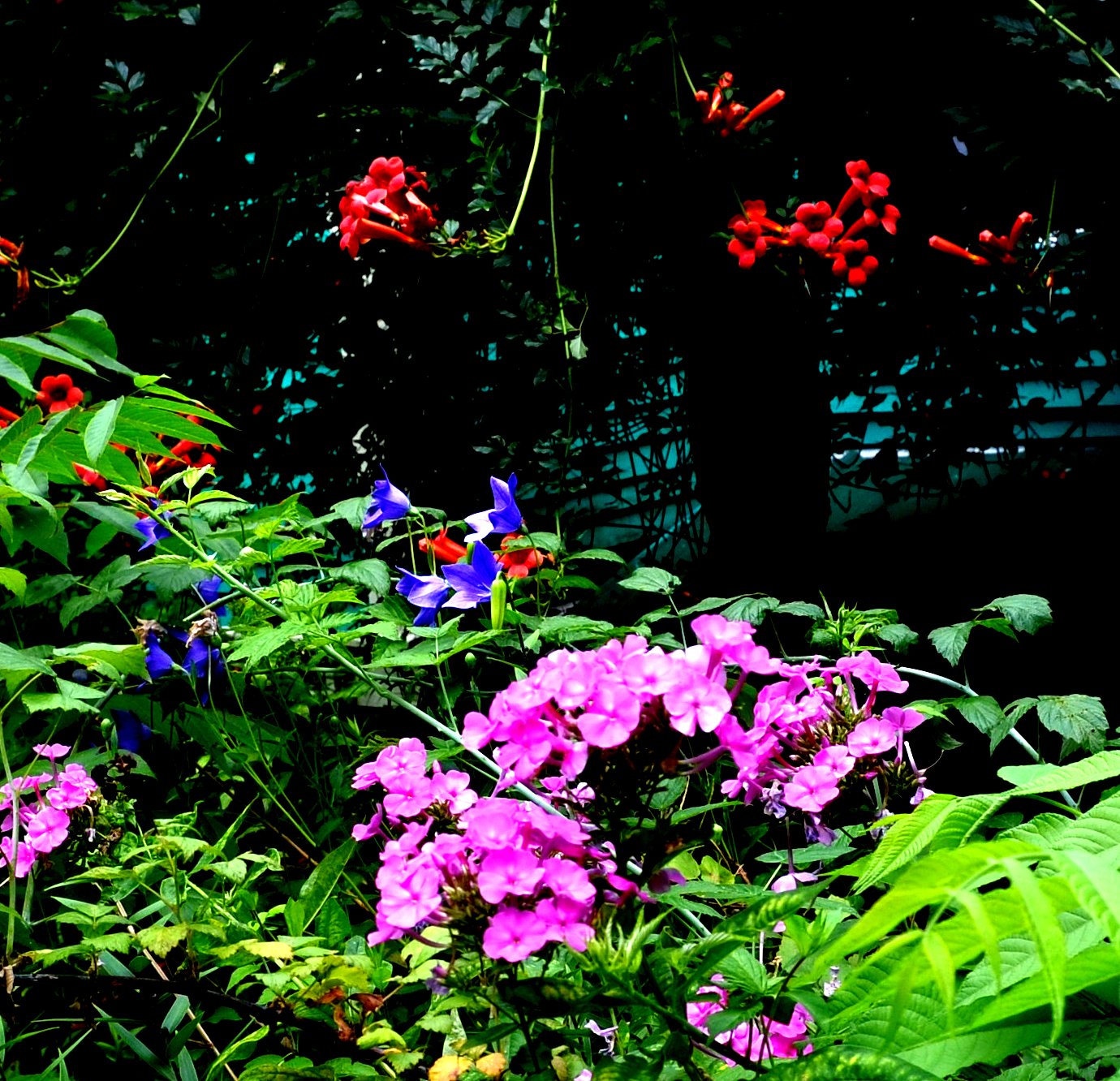
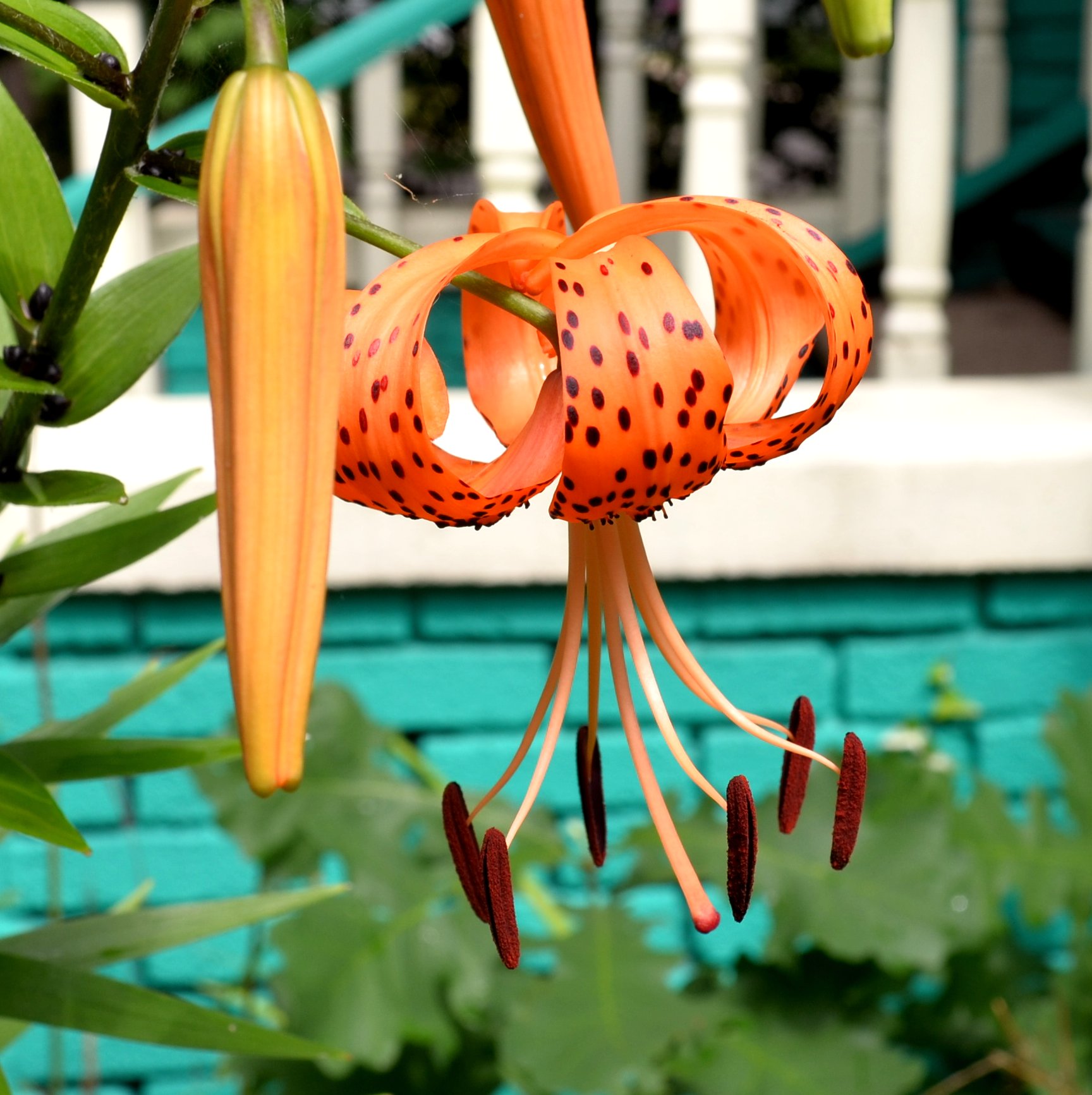
The trumpetvine is waning, but here is a honeybee gathering nectar and re-distributing pollen on one of its huge trumpets. This impression was shot from the neighbors' side of the back yard. There's trumpetvine at the top, blue balloon flowers, then phlox at the front. This week the tiger lilies began to open. This conjunction signals the end of July and that the goldenrod is about to start blooming. As a matter of fact, the goldenrod is beginning to set tiny buds.
Remember that there is information in the name of the file for each image. You can see it by mousing over the image - look at the lower left of the screen.
I would try clicking on the image. If the little "+" sign appears, it means you can enlarge again. While it is in "+" mode, click on something you want to see more clearly and it will zoom to that section. Then the info is displayed in the address line above. If the image has been cropped
so that clicking on it doesn't result in a larger picture, you can always hit control-plus to increase the size of the image.
A "carpenter ant". I've had them in the kitchen but they seem more interested in the sugar bowl than the woodwork. Among the aphids you can now see that the red aphids are not the only ones who bear live young. The green ones do too (lower left)! Fluffy here is either a wooly aphid or a gall aphid. You can see the aphid wings in white.
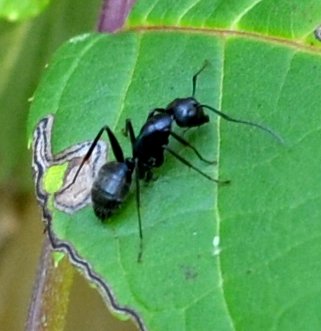
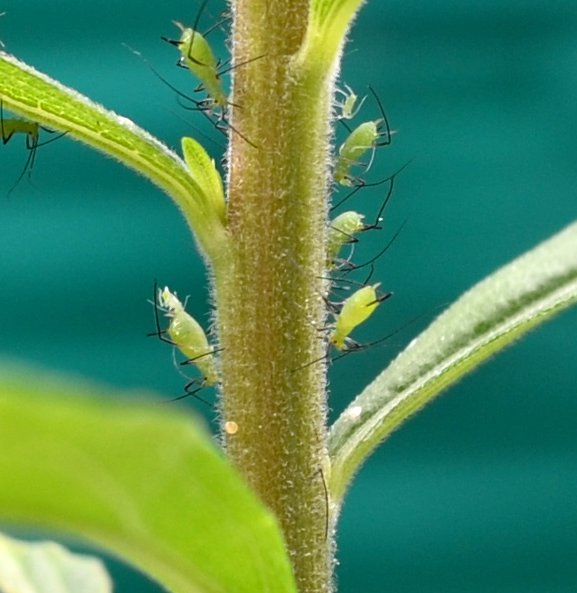
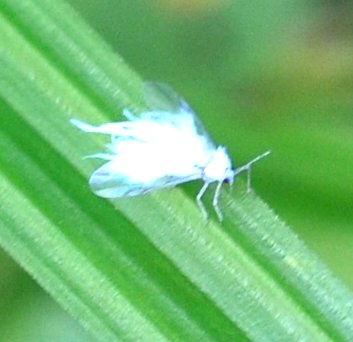
Here is a bumble bee, smaller than the usual big bumbling ones, in a thistle flower. The thistles now are attracting many kinds and sizes of bees. The second image is of a mason bee, the kind that pollinate so gladly, gathering said pollen on the bottom of their abdomens, not on their legs. The last shot shows three bees vying for the best nectar.
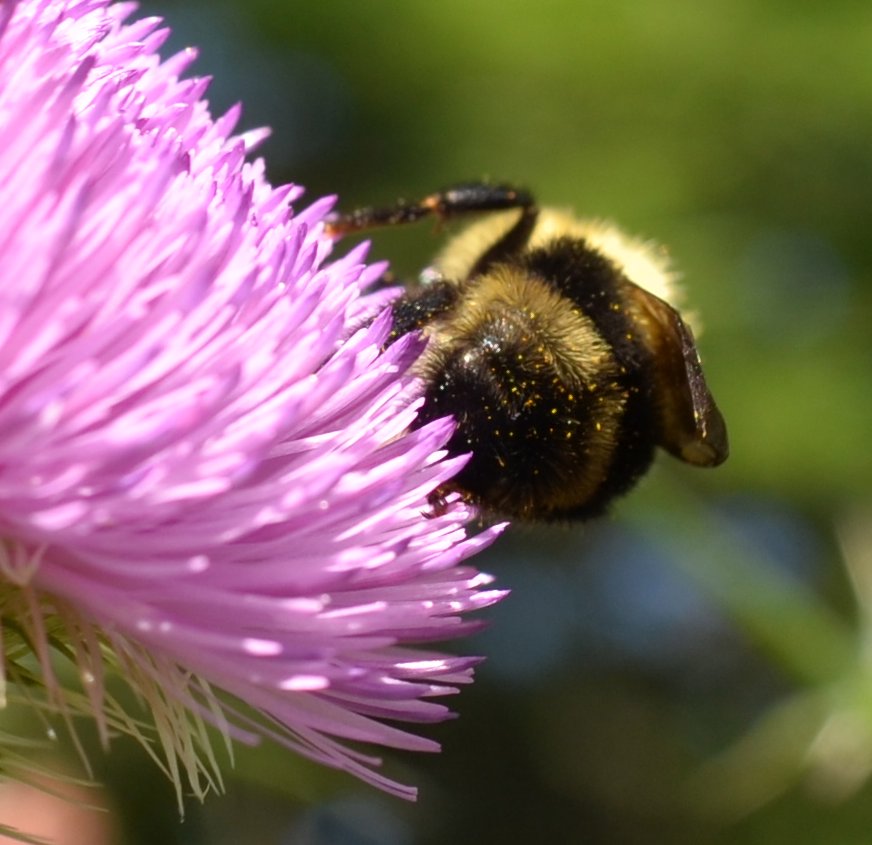 .
.
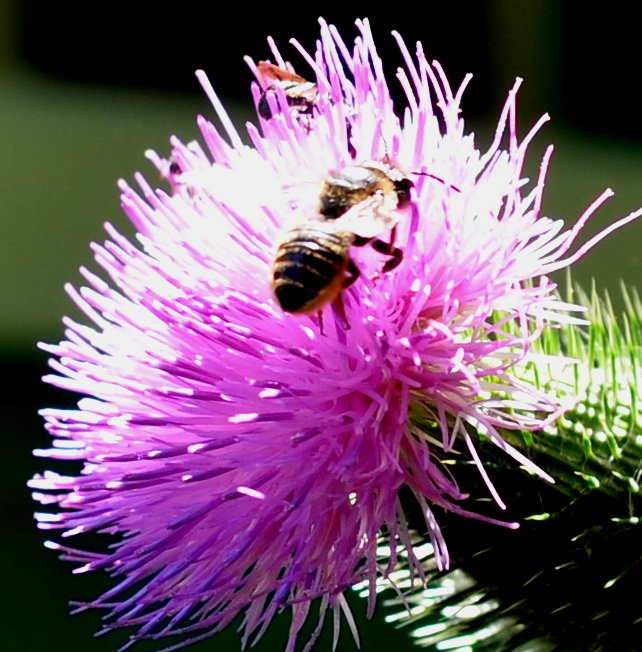
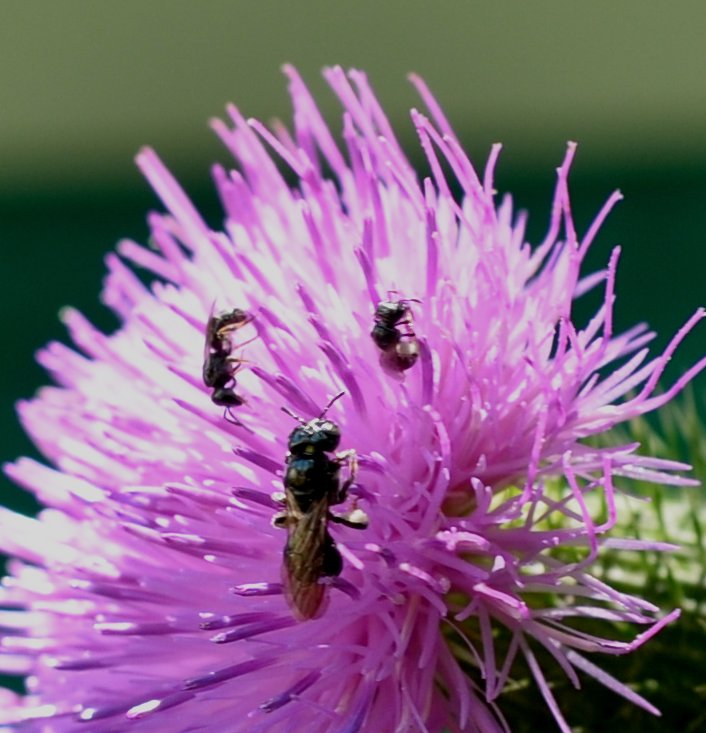
This little golden bee (descriptor, not name) was running back and forth on the leaves of my weeping redbud. And this one was doing the same kind of athletics on the raspberry leaves. (You can see at upper right the cluster of dessicated raspberries, suffering from lack of rain.)
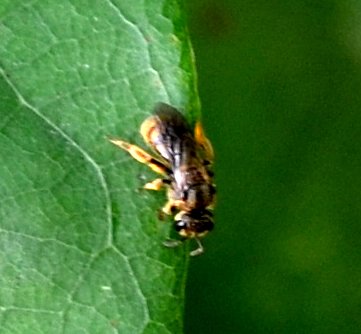
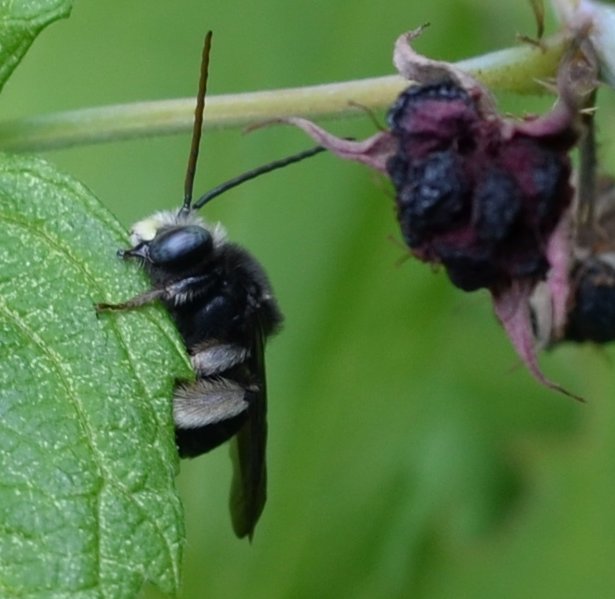
I learned some things about ladybugs (better: lady beetles) this week. Several colors and spot numbers are all categorized under "Multicolored Asian Lady Beetles (Harmonia axyridis)". The way you can tell one of these is by looking at their "faces" - if they have a "W" formation like this first image, they are the Asians, not our original ladybird beetle. Lady Beetles come in yellow, black and white as well as these black and white ones in the process of making a new cohort of black and white ones, and even these No-spotted ones, the Polished Lady Beetles. The second one is the Fourteen-spot Lady Beetle, and third is the Twenty-spot Lady Beetle.
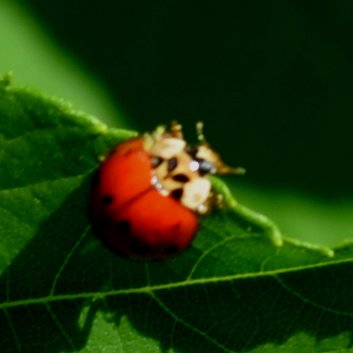 .
.
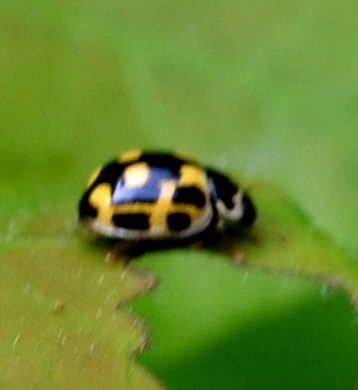
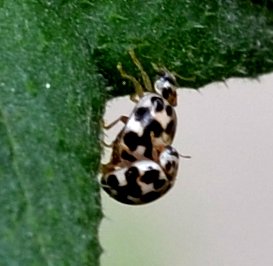
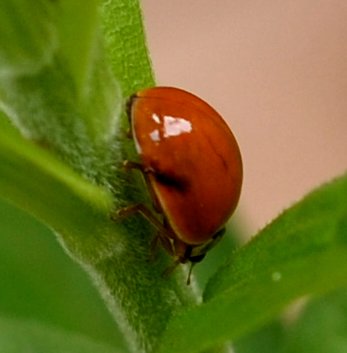
Something there is that does not love a click beetle: for instance, this tiny spider. This next one looked to me at first like a click beetle, but it is rather a false flower beetle!
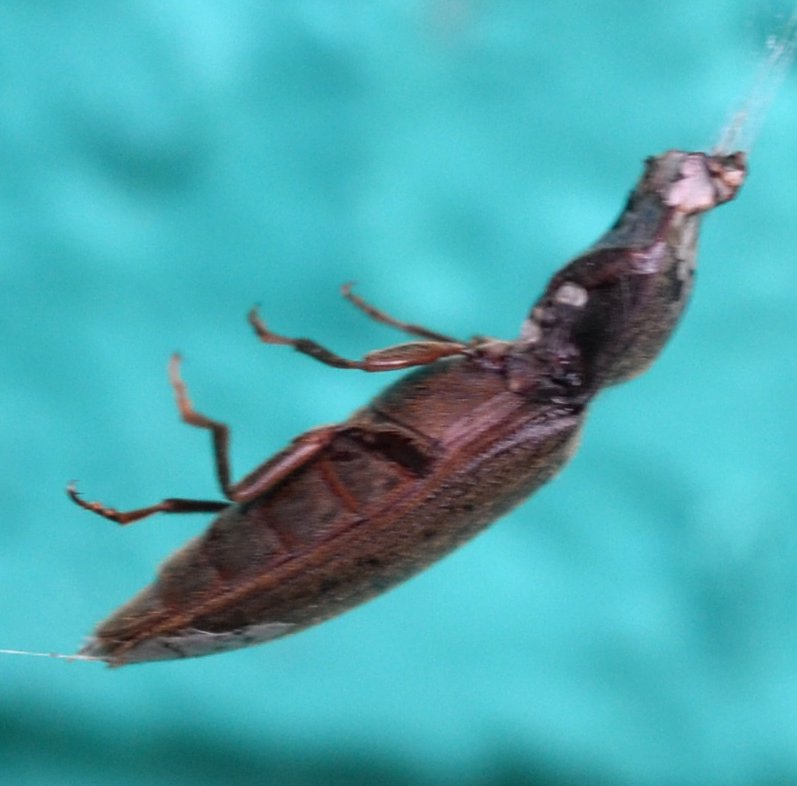
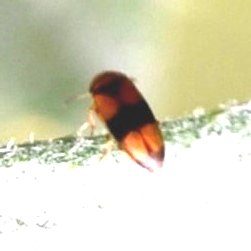
The exact tumbling flower beetle I could NOT identify, but its pointy tail gives it away as SOME kind of TFB. Here you see another lily-leaf beetle, a gorgeous thing, but showing the kind of mayhem it can wreak on seemingly ANY kind of lily leaf. That includes day lilies, tiger lilies, "real" lilies, including domestic and asiatic varieties. I pinch off quite a few but leave some just because they are so beautiful. Here a lightning "bug" is trying to catch some shade underneath a hosta leaf.
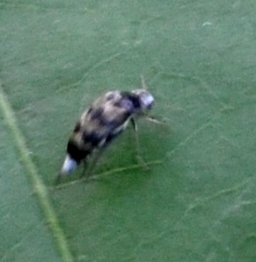
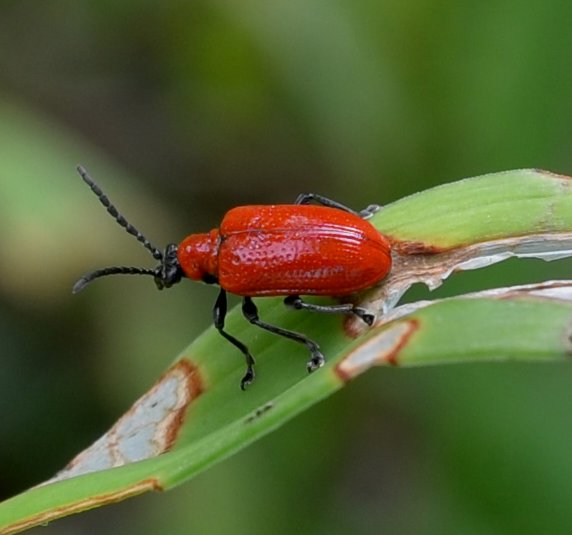
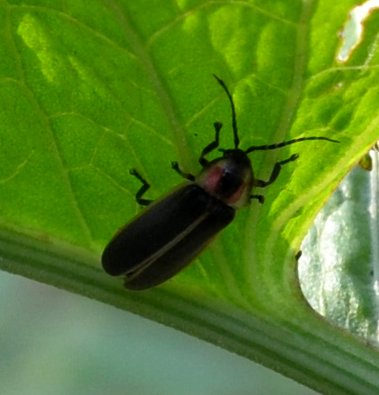
And then there were a few other kinds of beetle, whose names I don't know. A black one with white spots, a shiny goldish one, and something that I thought might be some kind of tortoise beetle, but turns out to be a bug - a Lace Bug. This may be the eggplant lace bug - or maybe the chrysanthemum lace bug. We do have some nightshade for the eggplant one to eat. Now I have to think of a relative of chrysanthemum around here to help me decide. They do look a lot alike.
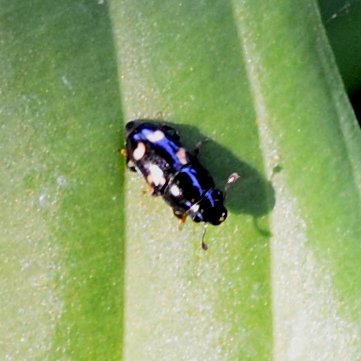
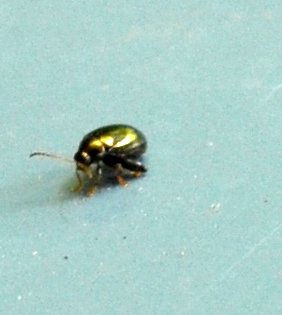
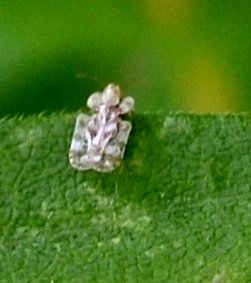
A couple of weevils. The first newer one resembles an elephant getting its legs into a lotus position, the second we've seen before.
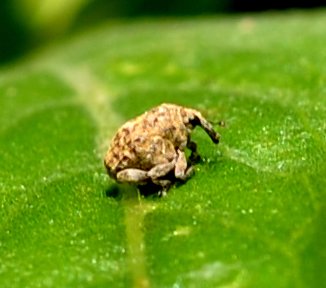
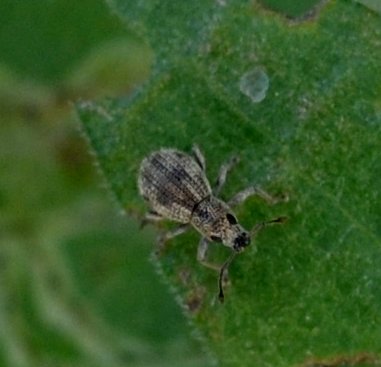
Bugs and more bugs! This minute assassin bug nymph is about the size of your pinky nail clipping. And the second is surely a
stilt bug.
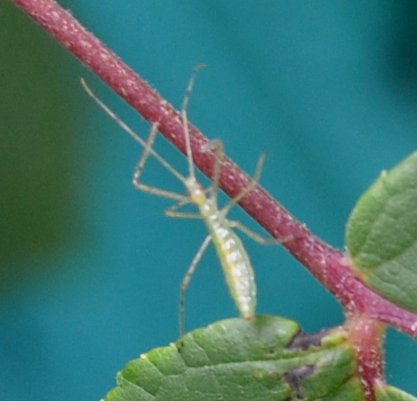
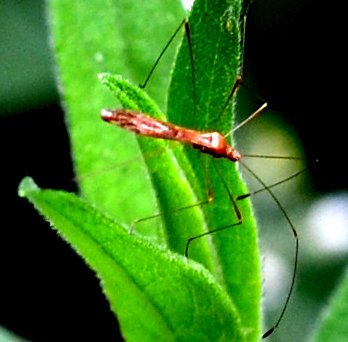
Here come the leafhoppers. First our old friend, the four-spotted Agallia. Then a new one giving me the hairy eyeball - wait - That one is a Planthopper!
,
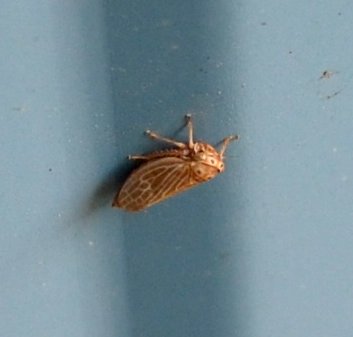
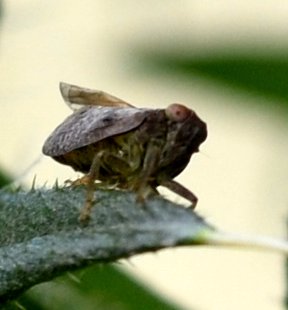
I think this year I've seen more red and green candy-stripers than red and blue ones. They keep the dark blue coloration at the ends of the wings though. The little Coelidia olitoria nymphs with their upturned tails and big yellow eyes, are getting larger and so my photos are giving more resolution.

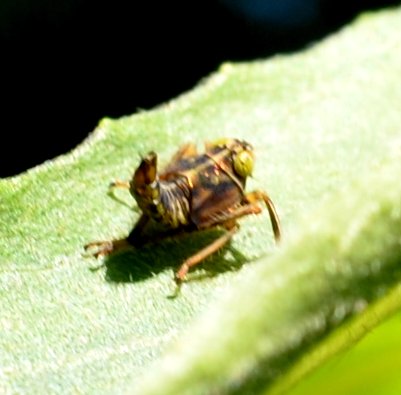
This little newcomer arrived a couple of days ago. And the Japanese maple leafhopper we have already seen fairly often. It is just such a lovely bluish green. The purplish-pink and green combination is a subtle stunner.
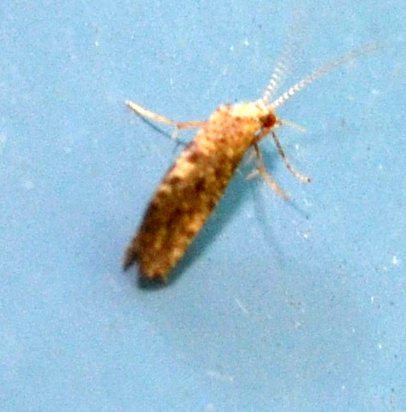
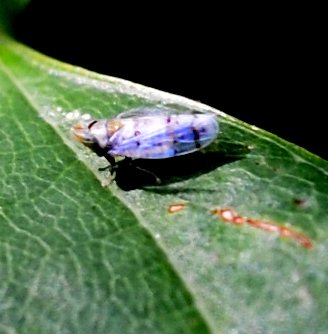

Several leafhoppers have these exquisite mosaic patterns.
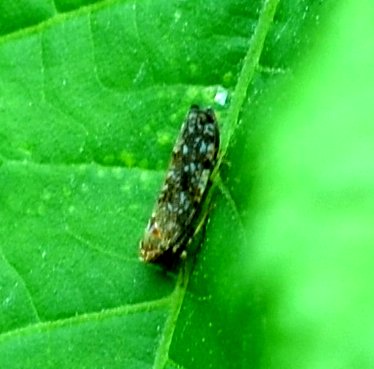
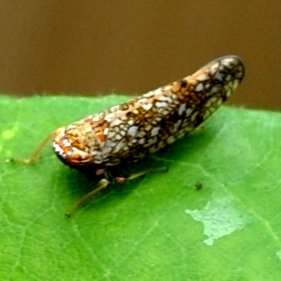
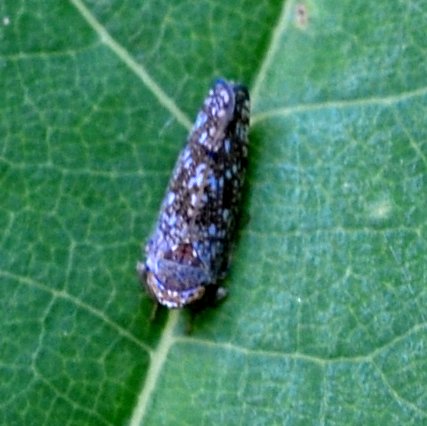
Here is a spittlebug that is different from the Alder spittlebug (or whatever variety we have here) in being black and white, instead of
brown and white. The buffalo treehoppers are back. Here is a dark and light kind, and a green kind. I'm glad to see them. I remember
being a kid looking at a bug book and thinking, "If only I could get a chance to see this bug, how happy I would be." And see, I'm still
glad to see them when they reappear each year!
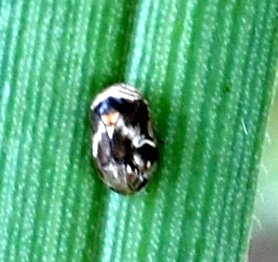

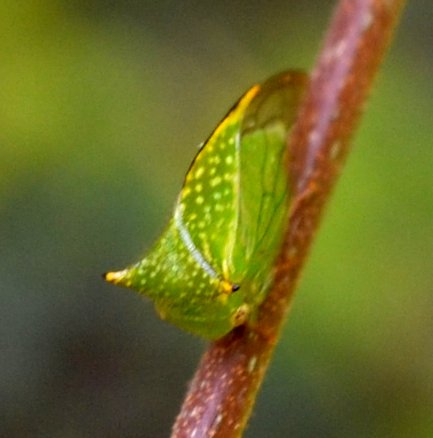
Here are a few bugs we haven't seen since last year. This is a very young nymph of a very large green stinkbug. Amazing to think it will turn into that solid green bug and not too much further to go... This rusty-red stink bug is very common around here. By the way, none of these stink bugs stink.

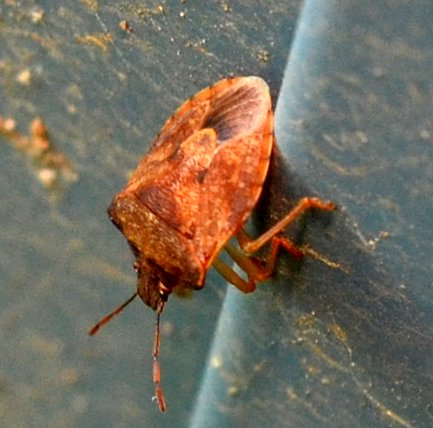
These little centipedes are all over nowadays. But the only caterpillar I've seen lately was this caterpillar roll at AKA Sushi.
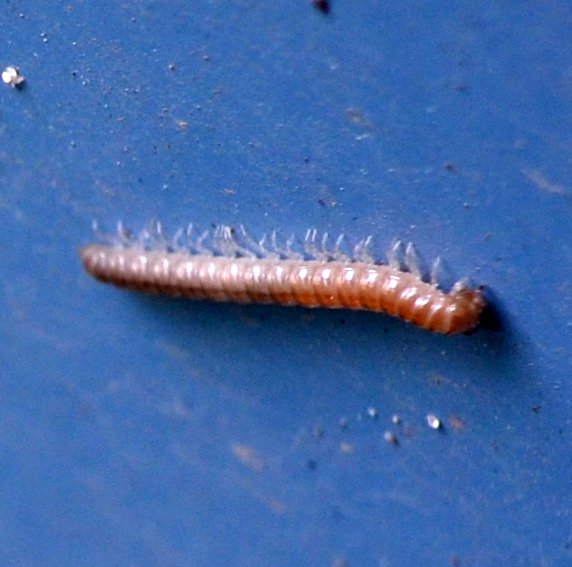

Last week I saw a dragonfly in a color combination I never expected. Big greyish blue eyes and the upper part of it also grey. But the underside is all bright orange. It is called a blue dasher. If you are trying to decipher the Latin species name, don't leave out the second "n".. Longipennis is really "long-winged". Anyway, that orange is not just a reflection off the trumpet. This little fellow has the right markings to be a Meadow Autumhawk. But is is much smaller than what I've seen of them. This damselfly has the exclamation points of one of the forktails, hmm, eastern or fragile! That's it. The fragile forktail has the two exclamation points.
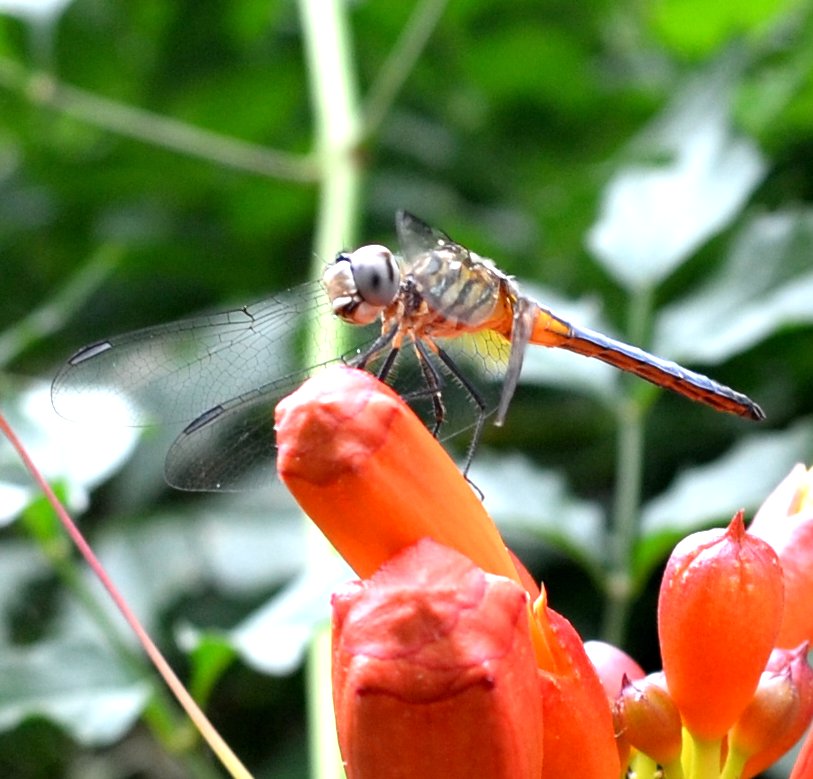
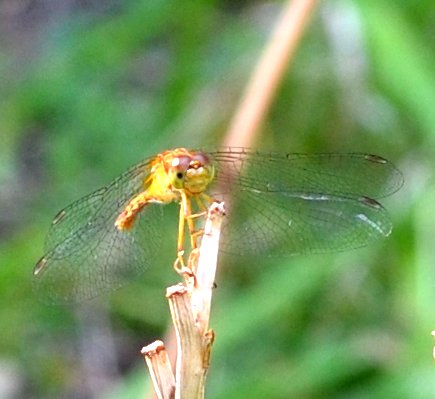
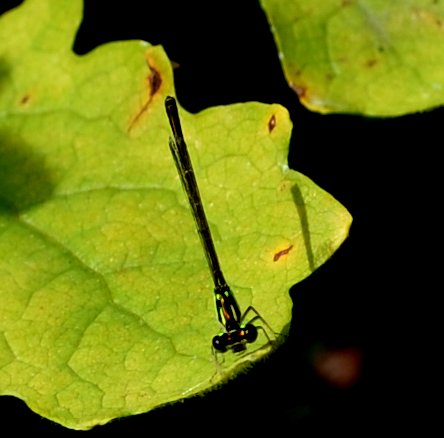
As the leafhoppers hogged the scene this week, the flies were a bit reticent. But we had a few hoverflies. Most if not all are ones we've seen before. But their cheerful colors and dispositions (some look like bees but don't sting!)make it a treat to see them whenever they appear.
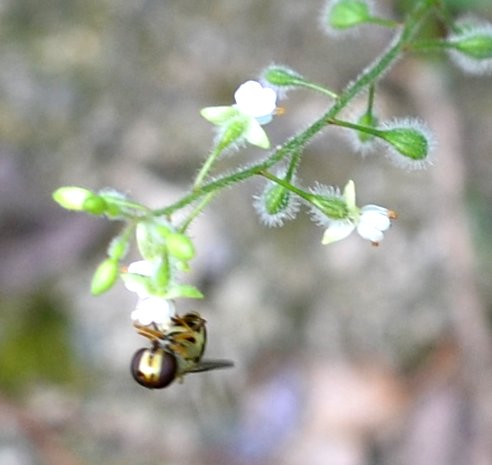
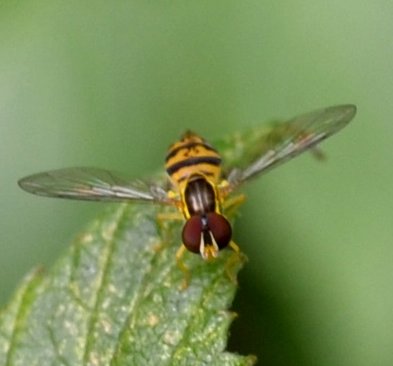
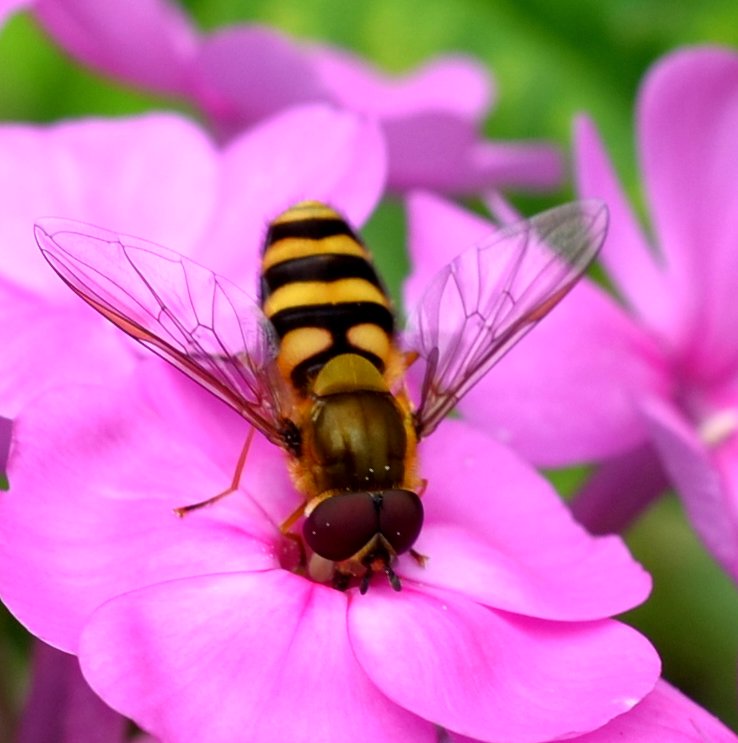
The long-legged flies are still easy on the eyes. And this one that looked like a mosquito with iridescent eyes dazzles mine.
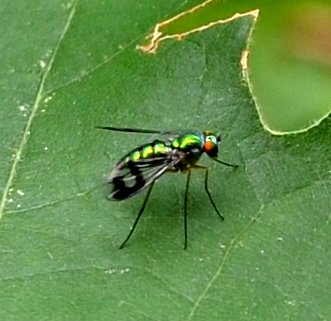
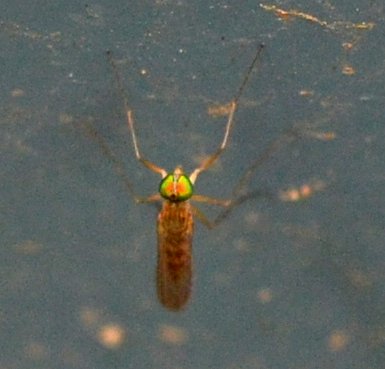
Here are a couple of flies that could star as villains in a nature opera. The first one is just a hairy little grouch. Then a robberfly, one of our thinners of the bug population. Last is probably not so villainous, but I need to comb its files to find out its dark secret (if any).
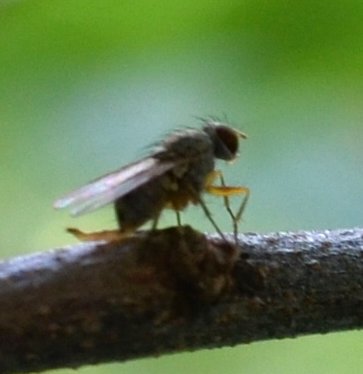
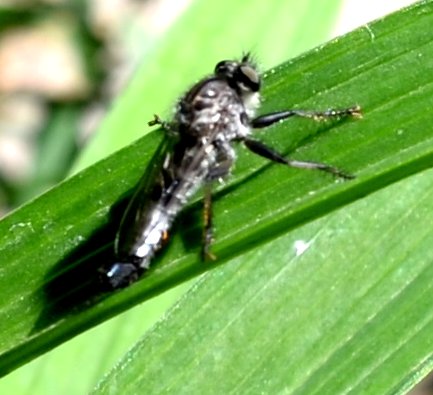
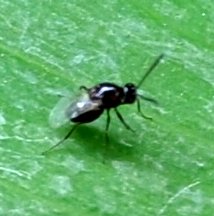
The harvestmen just seem to be more and more attractive. I don't remember seeing one like this red-vested model before. But the second one is one of our old friends, and the pinkish-orangey one is another.
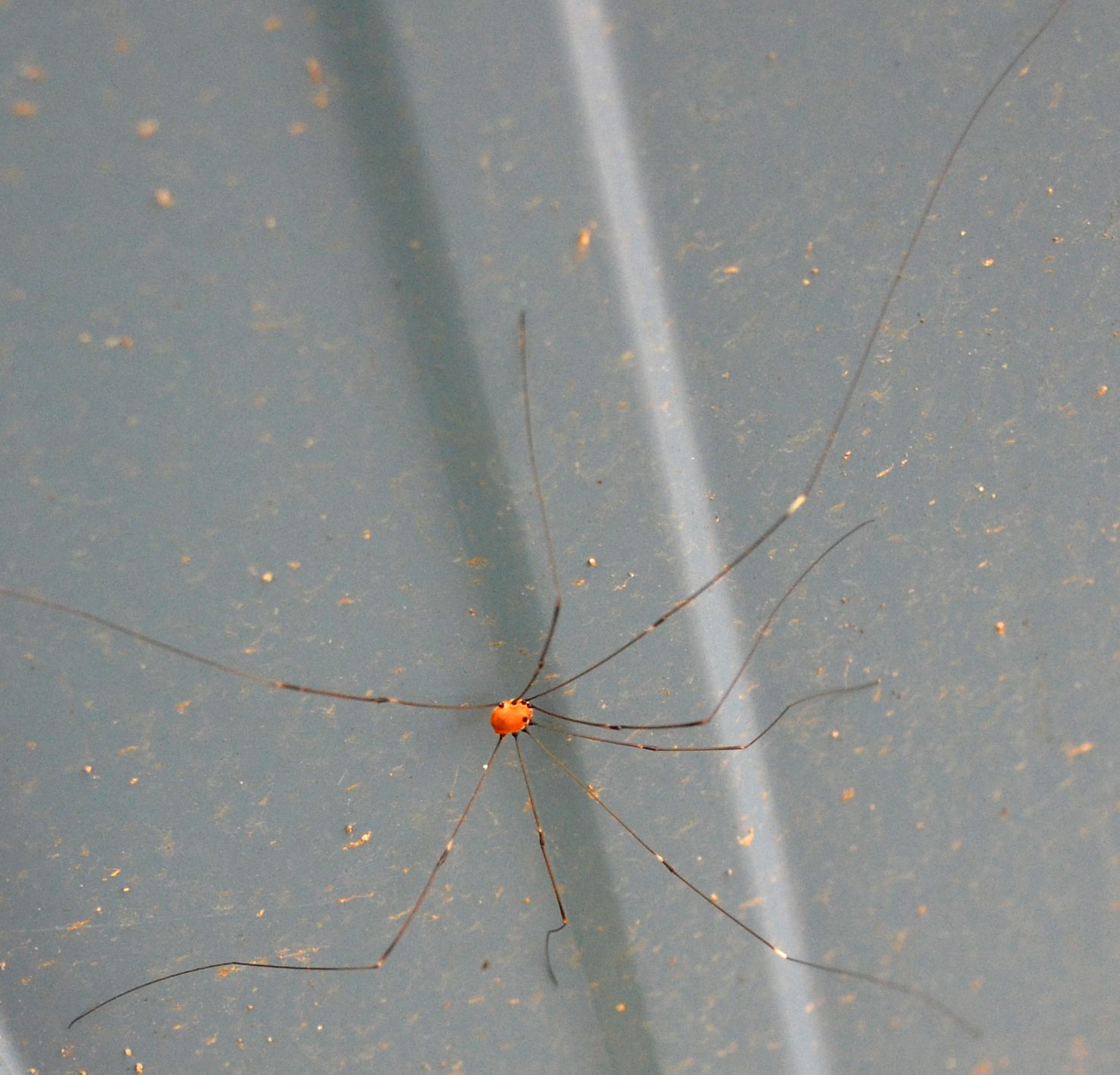
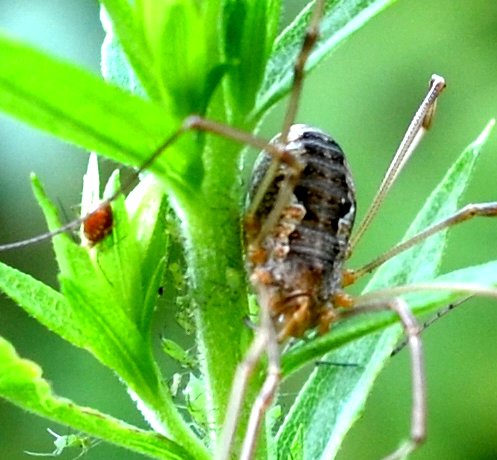
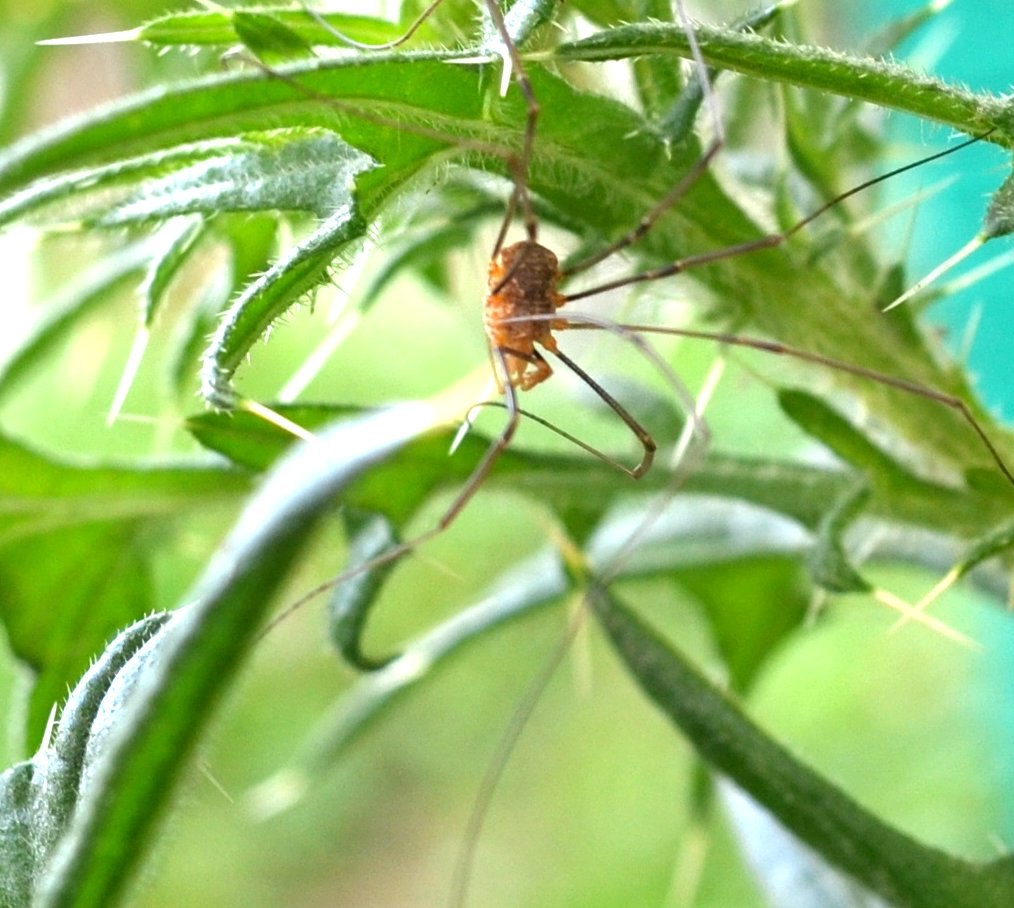
Let's see if we have some more floral images before we go on. This minature zinnia has a little fluff bug on it. I don't know which kind of fluff bug. And this thistle is inhabited by the tiniest little crab spider! This spiderwort is stunning in its purple leaves and violet flower.
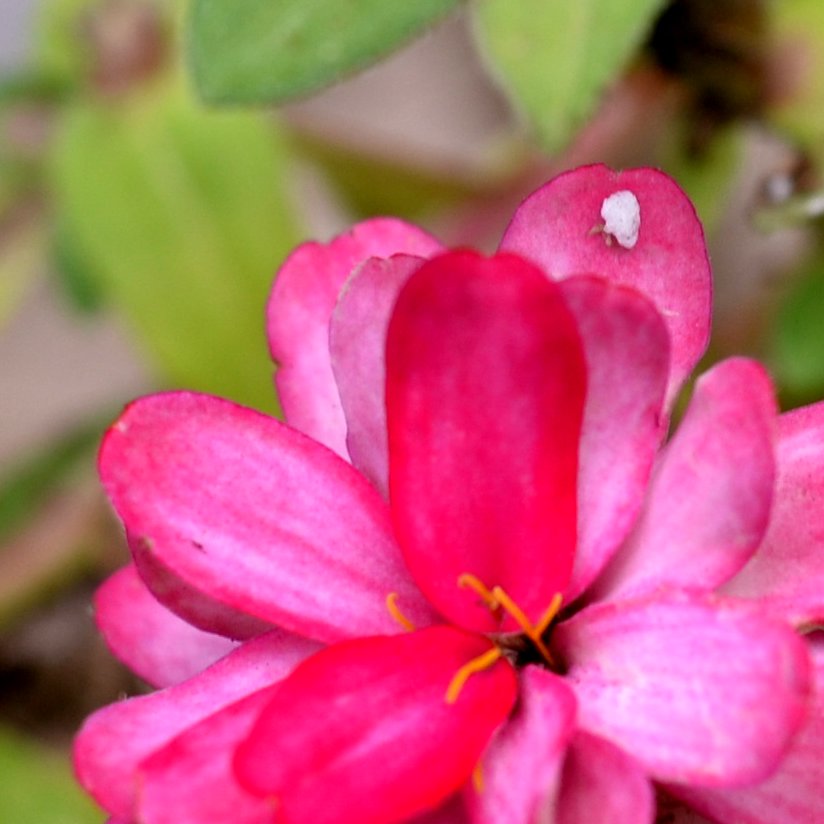
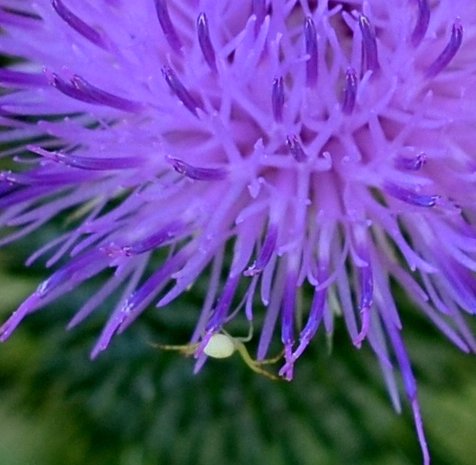

We had a few new unknown moths. This tiny one has appeared in a different spot in the garden three years running. It is a Skullcap Skeletonizer Moth. This black on grey one was such a surprise when I spotted it. It's a Shining Dichomeris Moth. And this third one which seems to be propped up on its hind legs jogs my memory and comes up with a possible leaf miner moth.
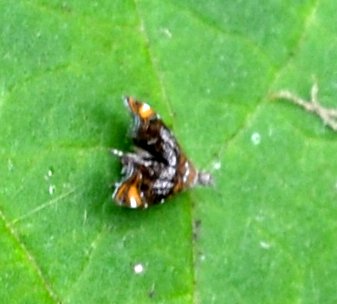
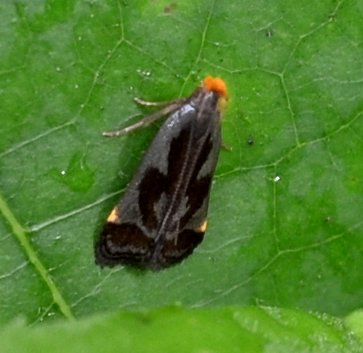
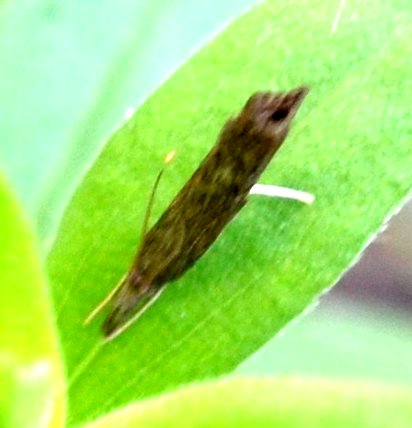
It was a great week for Orthopterans: katydids, grasshoppers, and crickets! Remember we've been seeing little two-spotted tree cricket nymphs for a while? I think this one is actually an adult. It seemed to be pressing that stick-like thing on its rear end into the leaf, so I'm thinking this is an adult female. But I'm still puzzled as to what the two spots the name refers to. Any guesses? Image 3 is either a katydid nymph or a grasshopper nymph. According to Bugguide.net, long antennae in this nymph signifies a katydid nymph.
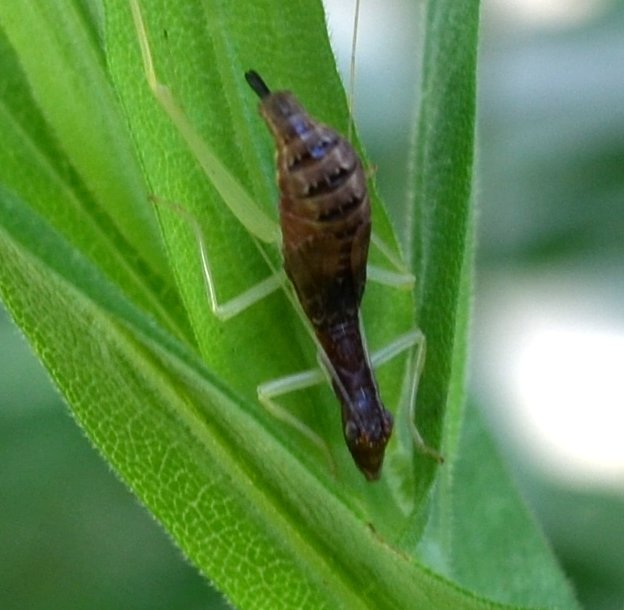
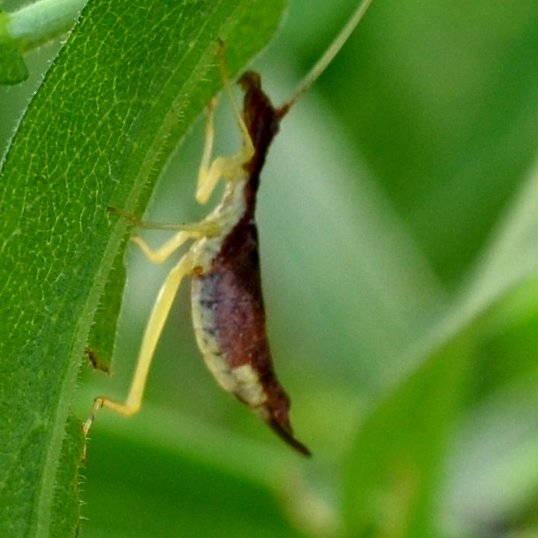
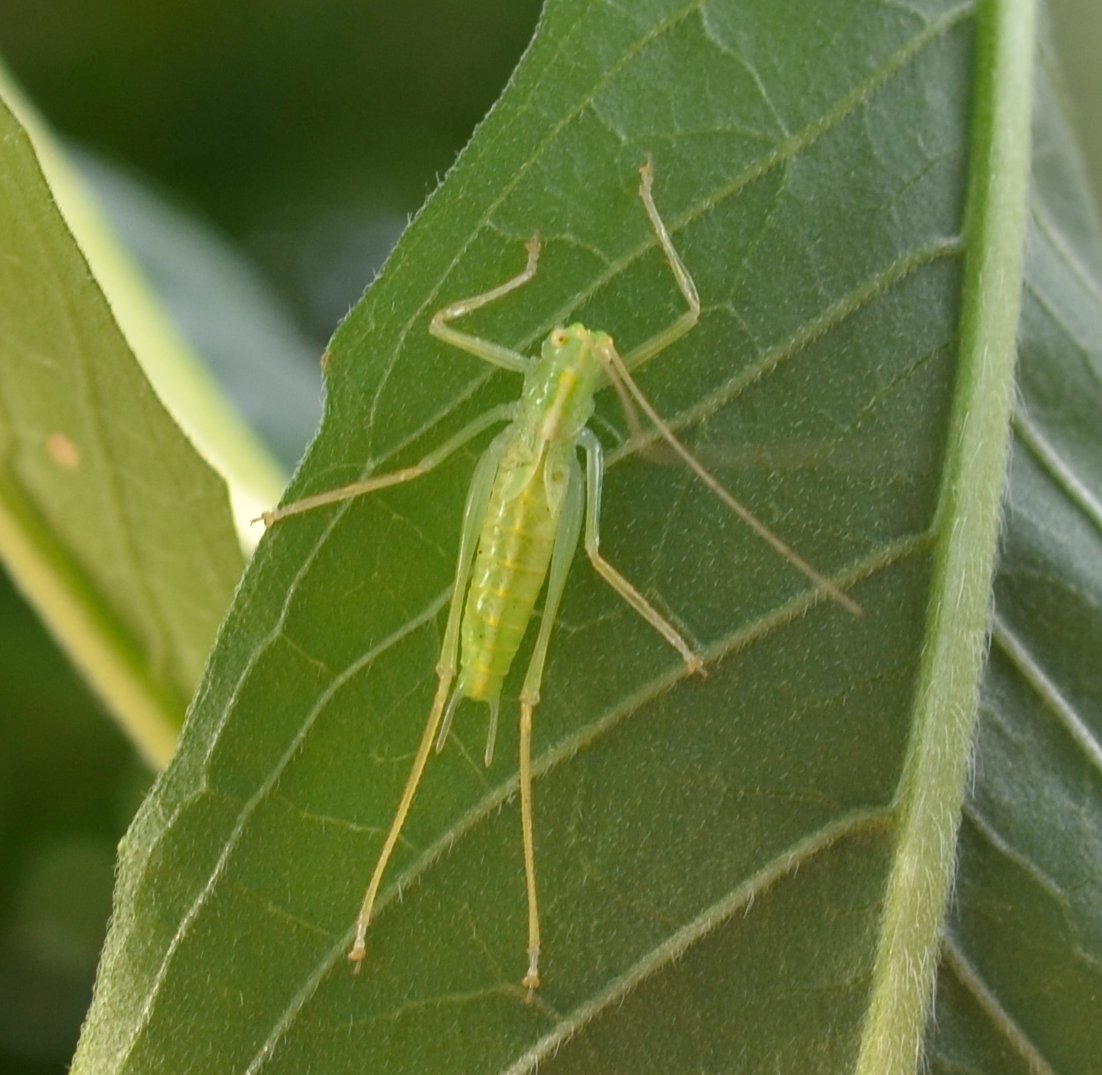
The bush katydid's nymph is so very beautiful! I wish I could separate the nymphs of the Bush Katydid and the Forktailed Bush Katydid. They both have so many colors! Here are two older Katydid nymphs.
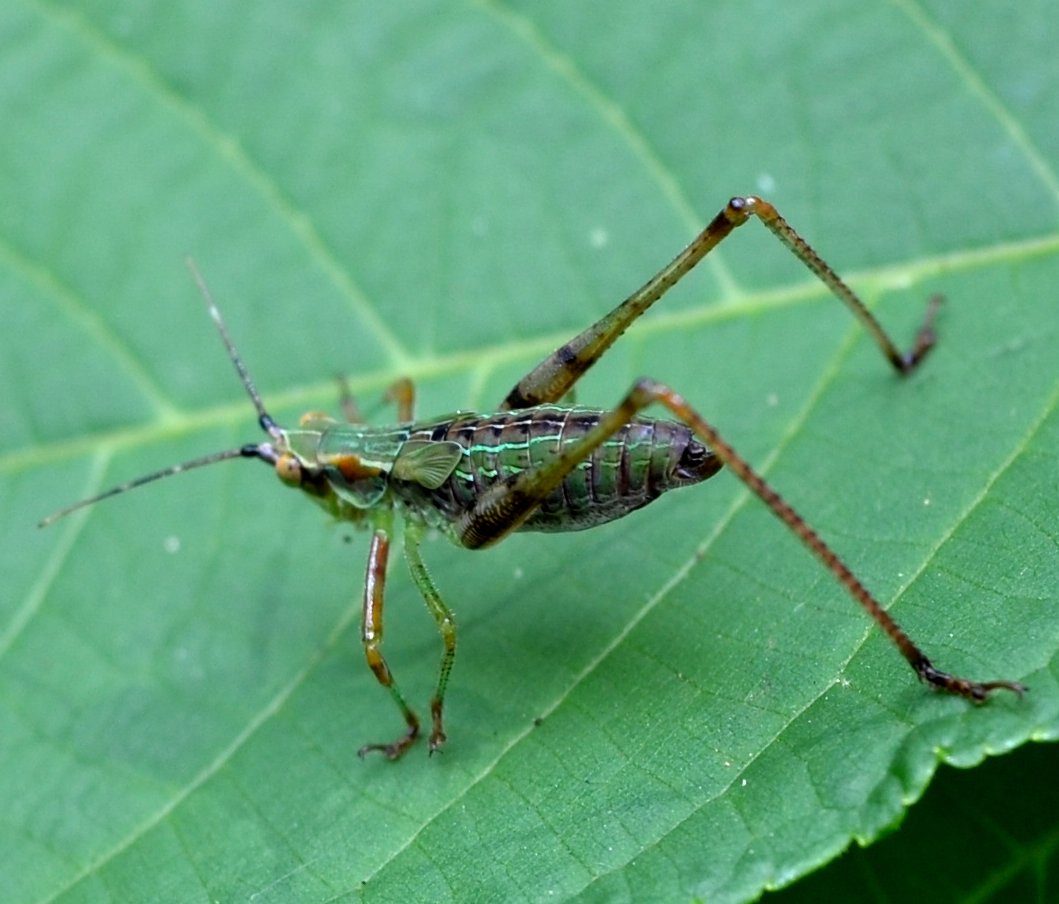
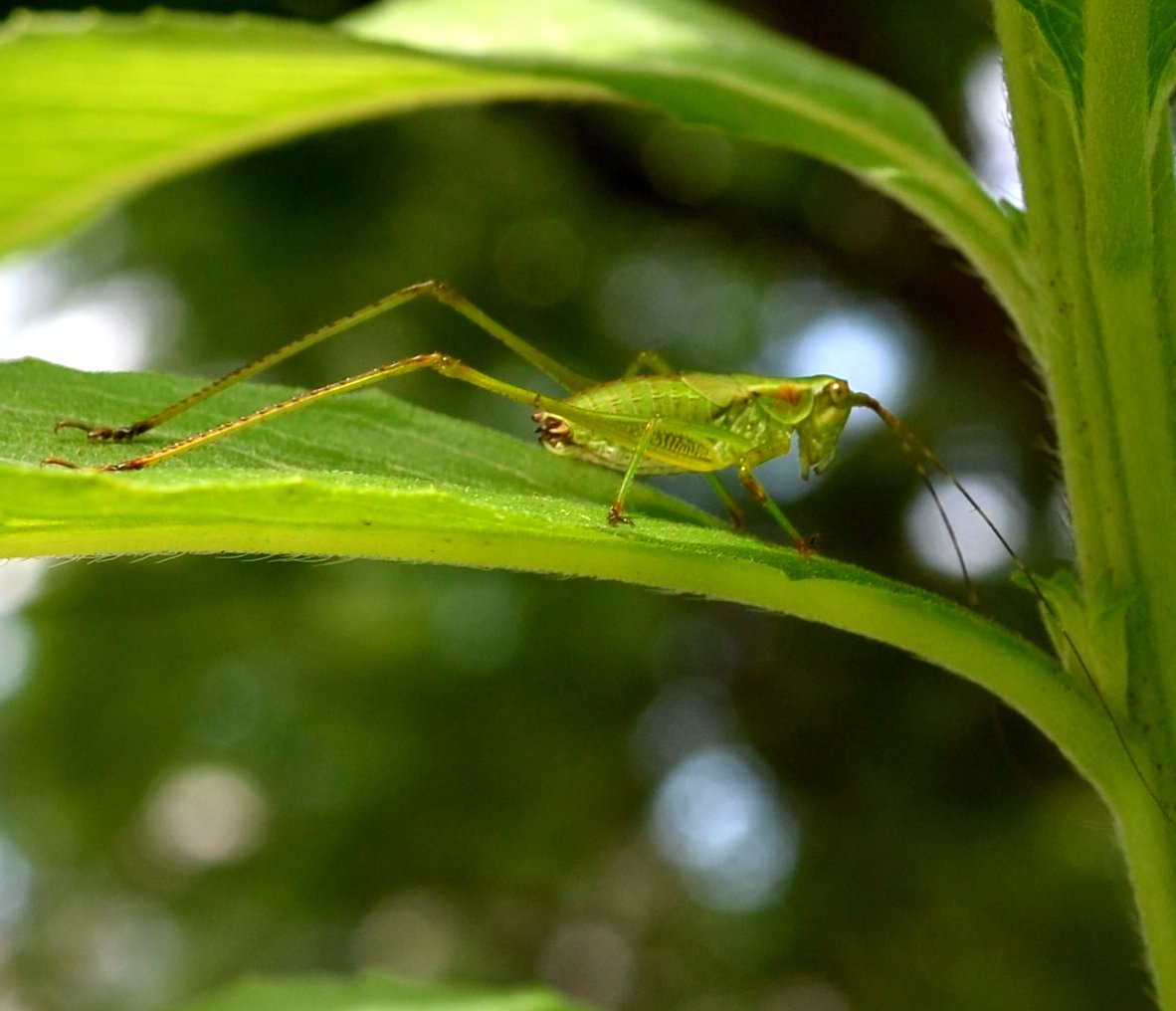
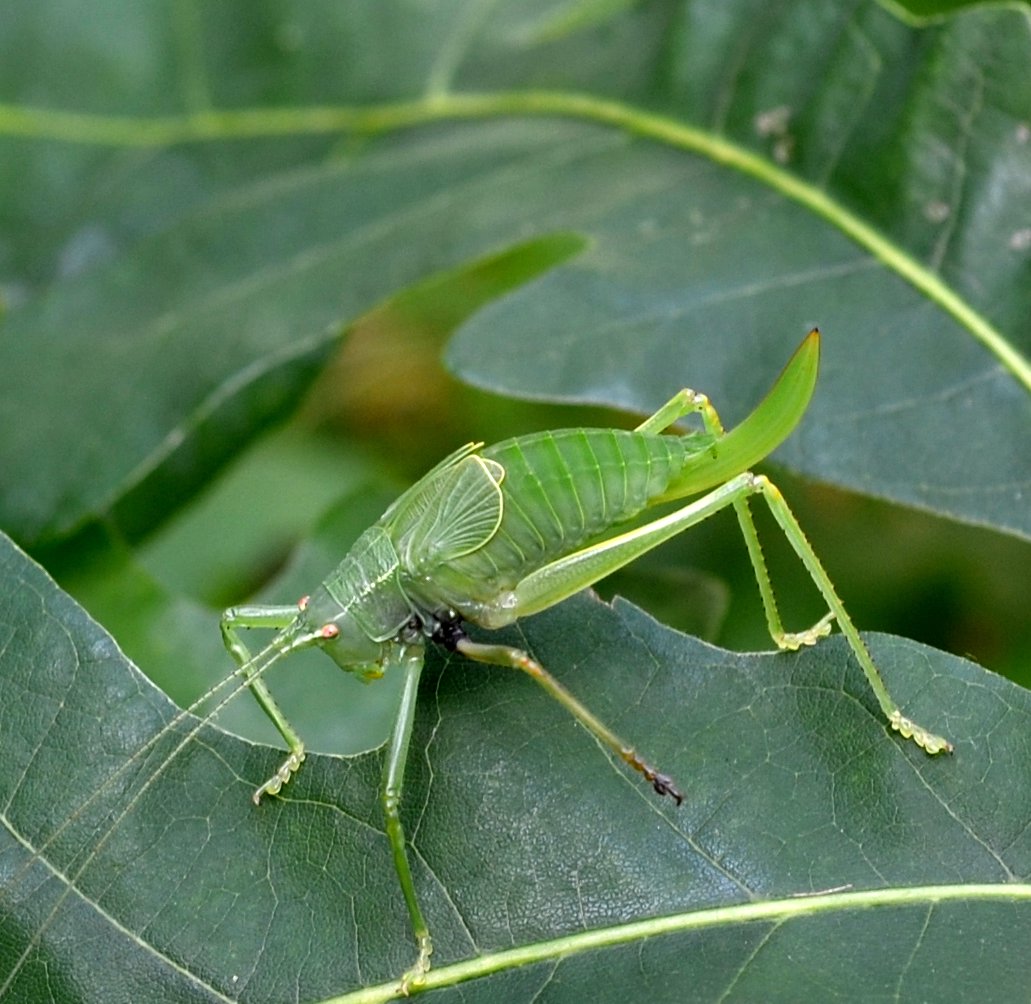
All right, spider time. Here is a grass spider at work in its sheet web; the little orbweaver that we saw last week in the kitchen; and a pirate spider, with its white eyes (making it Mimetus puritanus).
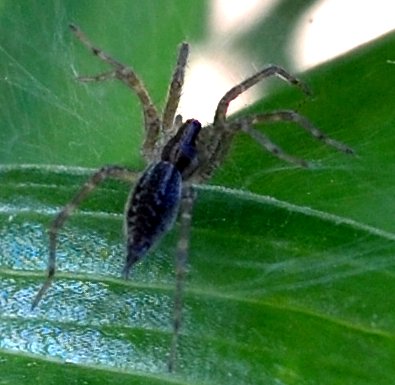
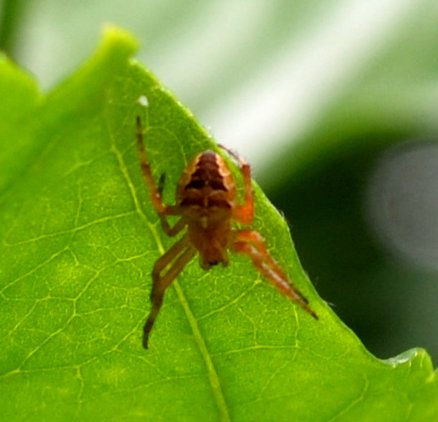
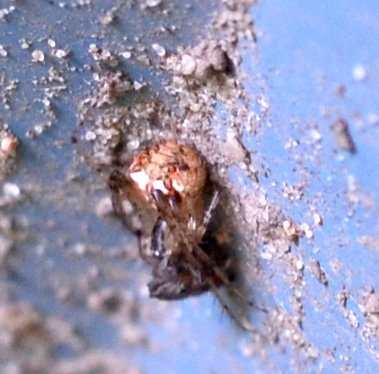
Can you believe that I have only a few wasp pictures to show you? Maybe next week will be more generous with them. In the meantime, here is a common house spider wrapping up some kind of wasp for its supper; possibly an ichneumon but so pretty; another possible ichneumon.
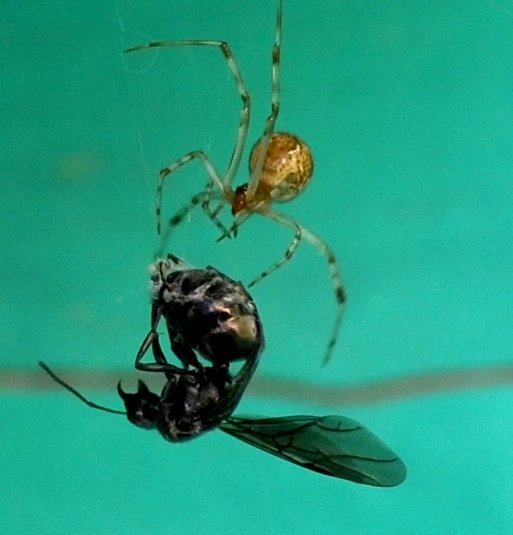

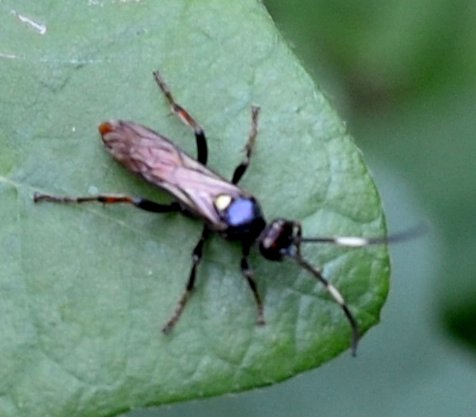
Finally! The nest in the air conditioner. I took this one several days ago and was amazed to see the changes in it as it grew from a tiny little nest the size of the rightmost little nest to become this monster nest.

I wish you could be here but that would be wishing you this heat and humidity. So I wish I were there with you if you aren't in the hot zone. Have a great new week and send me any pictures of where you are that you think others would enjoy seeing!
Love! from Martha
P.S. This morning it rained like crazy for at least an hour. I hope it rescues some of our crops. When it was over, it was still hot and maybe even more humid. So wait a while to buy your ticket. Love again!
Back to July 17
On to July 31
Back to 2016 menu
Back to main menu
copyright Martha O'Kennon 2016









 .
.




 .
.
































































